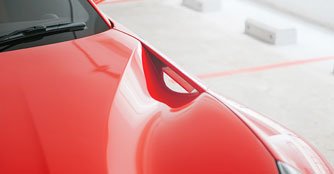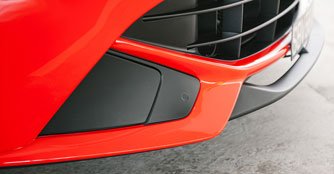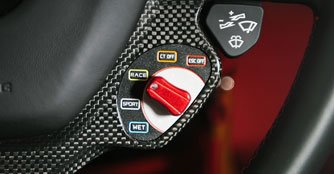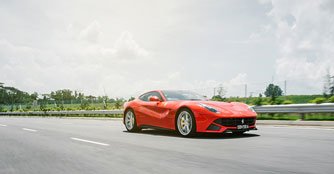Ferrari F12berlinetta 6.3 (A) Review
04 Sep 2013|22,740 views
No matter how many times the words 'bespoke' and 'fantasy' have been overused and brutalised in the realm of supercars, you simply can't deny that engineering brilliance and impeccable attention to details can make a difference between good and great cars.
By now, you should have already come to a decision that the F12berlinetta isn't just your ordinary car. Introduced to the world in 2012 at the Geneva Motor Show, the F12berlinetta (let's just refer to it as F12 for convenience sake) is a front mid-engine, rear-wheel drive car that replaces the Ferrari 599 GTB.
Exterior
While past Ferrari models like the 458 and the F430 were more understated, recent models like the FF and the F12 here are more aggressive-looking without coming off as overly harsh. While the Lamborghini Aventador is more provocative and forthright with its looks, the F12, with its sinister smile, is more sedated and more stunning.
The car looks amazing from any angle, with its shape exuding a sense of style, stability and strength. The long, low body is wrapped in dramatically swooping lines that are hard to miss.
By now, you should have already come to a decision that the F12berlinetta isn't just your ordinary car. Introduced to the world in 2012 at the Geneva Motor Show, the F12berlinetta (let's just refer to it as F12 for convenience sake) is a front mid-engine, rear-wheel drive car that replaces the Ferrari 599 GTB.
Exterior
While past Ferrari models like the 458 and the F430 were more understated, recent models like the FF and the F12 here are more aggressive-looking without coming off as overly harsh. While the Lamborghini Aventador is more provocative and forthright with its looks, the F12, with its sinister smile, is more sedated and more stunning.
The car looks amazing from any angle, with its shape exuding a sense of style, stability and strength. The long, low body is wrapped in dramatically swooping lines that are hard to miss.
 |
Melding aerodynamics with aesthetics, the car sports aero bridge channels above the front wheel arches, creating an effect that increases downforce.
Flanking the grille is the active brake cooling ducts, which open to direct cooling air only when the brakes are hot and keeping them closed at other times to reduce aerodynamic drag.
Sitting at 4,618mm long, 1,942mm wide and 1,273mm tall, the F12 is significantly more compact than the 599, with shorter overhangs and a lower centre of gravity. As a result, the car you see here is also lighter than its predecessor by almost 60kg.
 |
Interior
Slip into the optional two-tone driver's seat and the oversized tachometer dominates your view, accompanied by the in-dash TFT screen that gives you a summary of the car's essentials and dynamics, which can be toggled through the manettino located on Ferrari's F1-inspired steering wheel.
On that note, everything is centred around the driver here. There are no stalks behind this steering wheel. Instead, the signal indicators, horn, starter button and the said manettino toggle are housed here, further ensuring that nothing gets in the way of the paddle shifters.
An alloy bridge arcs neatly from the dash to the centre console and houses a trio of buttons that are within reach from the seat - 'R' to select reverse gear, 'Auto' to engage the gear and 'Launch' for a neck-breaking experience from standstill.
Slip into the optional two-tone driver's seat and the oversized tachometer dominates your view, accompanied by the in-dash TFT screen that gives you a summary of the car's essentials and dynamics, which can be toggled through the manettino located on Ferrari's F1-inspired steering wheel.
On that note, everything is centred around the driver here. There are no stalks behind this steering wheel. Instead, the signal indicators, horn, starter button and the said manettino toggle are housed here, further ensuring that nothing gets in the way of the paddle shifters.
An alloy bridge arcs neatly from the dash to the centre console and houses a trio of buttons that are within reach from the seat - 'R' to select reverse gear, 'Auto' to engage the gear and 'Launch' for a neck-breaking experience from standstill.
As opposed to hard and uncomfortable bucket seats often associated with supercars, the body-hugging benches on the F12 offer a nice blend of comfort and support. And despite the car's low-slung looks, the interior offers reasonable amounts of headroom even for the tallest of occupants.
Everywhere else is a classic mix of rich leather, aluminium touches and optional carbon fibre trimming.
Everywhere else is a classic mix of rich leather, aluminium touches and optional carbon fibre trimming.
 |
The Drive
Just like the FF, the lightning quick seven-speed F1 dual-clutch gearbox is seamlessly mated to the 6.3-litre V12 that's mounted underneath the bonnet in front of the driver. But unlike the FF, the F12 here musters more power and torque, churning a maximum output of 740 prancing horses at a dizzying 8,250rpm and 690Nm of torque at 6,000rpm.
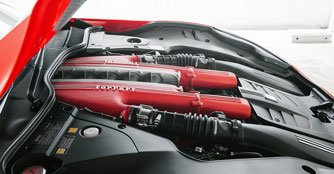
 Thanks to the competent V12 powerplant, the F12berlinetta will complete the century sprint in 3.1 seconds before reaching a top speed of 340km/h
Thanks to the competent V12 powerplant, the F12berlinetta will complete the century sprint in 3.1 seconds before reaching a top speed of 340km/h
More impressively, despite its high revving nature, the powerplant is flexible and has ample pulling power from lower end of the range to give the car a generous shove regardless of the speed you are travelling in or the driving mode you've selected.
As a result, the F12 is a joy to behold. It's so easy to drive, with a linear but superfast delivery through the rear wheels. Even if you decide against threading the throttle pedal with caution, the 690 twisting force won't annihilate the rear tyres in an instant.
Instead, the F12 catapults you towards the horizon in a steady manner the very moment you decide to squeeze the throttle, with the reliable gearbox shifting as quickly and immediately as you can flick the paddle shifters.
Just like the FF, the lightning quick seven-speed F1 dual-clutch gearbox is seamlessly mated to the 6.3-litre V12 that's mounted underneath the bonnet in front of the driver. But unlike the FF, the F12 here musters more power and torque, churning a maximum output of 740 prancing horses at a dizzying 8,250rpm and 690Nm of torque at 6,000rpm.

More impressively, despite its high revving nature, the powerplant is flexible and has ample pulling power from lower end of the range to give the car a generous shove regardless of the speed you are travelling in or the driving mode you've selected.
As a result, the F12 is a joy to behold. It's so easy to drive, with a linear but superfast delivery through the rear wheels. Even if you decide against threading the throttle pedal with caution, the 690 twisting force won't annihilate the rear tyres in an instant.
Instead, the F12 catapults you towards the horizon in a steady manner the very moment you decide to squeeze the throttle, with the reliable gearbox shifting as quickly and immediately as you can flick the paddle shifters.
Drive thus, you'll dash across the 100km/h mark in a rapid 3.1 seconds, accompanied by a rich and reverberating roar from the exhausts that will easily wake the entire neighbourhood up.
Admittedly, driving a supercar that doesn't belong to you can be stressful. But with the car's talkative and well-weighted steering, as well as a high seating position, there are no calls for anxiety. Every degree of motion results in a predictable reaction from the car. Thus, there's a lot of trust and very little fuss when piloting the F12.
On the road, you can hardly feel any form of harshness with the Ferrari. Thanks to the car's damping controls, the ride is acceptably supple, making it a commendably civilised conveyance.
Conclusion
Ferrari has outdone itself by producing a civilised supercar that's not only vastly quicker than its predecessor but also more enjoyable and comfortable at lower speeds.
Looks like the Italian carmaker is not going to have an easy time replacing the F12berlinetta.
Admittedly, driving a supercar that doesn't belong to you can be stressful. But with the car's talkative and well-weighted steering, as well as a high seating position, there are no calls for anxiety. Every degree of motion results in a predictable reaction from the car. Thus, there's a lot of trust and very little fuss when piloting the F12.
On the road, you can hardly feel any form of harshness with the Ferrari. Thanks to the car's damping controls, the ride is acceptably supple, making it a commendably civilised conveyance.
Conclusion
Ferrari has outdone itself by producing a civilised supercar that's not only vastly quicker than its predecessor but also more enjoyable and comfortable at lower speeds.
Looks like the Italian carmaker is not going to have an easy time replacing the F12berlinetta.
No matter how many times the words 'bespoke' and 'fantasy' have been overused and brutalised in the realm of supercars, you simply can't deny that engineering brilliance and impeccable attention to details can make a difference between good and great cars.
By now, you should have already come to a decision that the F12berlinetta isn't just your ordinary car. Introduced to the world in 2012 at the Geneva Motor Show, the F12berlinetta (let's just refer to it as F12 for convenience sake) is a front mid-engine, rear-wheel drive car that replaces the Ferrari 599 GTB.
Exterior
While past Ferrari models like the 458 and the F430 were more understated, recent models like the FF and the F12 here are more aggressive-looking without coming off as overly harsh. While the Lamborghini Aventador is more provocative and forthright with its looks, the F12, with its sinister smile, is more sedated and more stunning.
The car looks amazing from any angle, with its shape exuding a sense of style, stability and strength. The long, low body is wrapped in dramatically swooping lines that are hard to miss.
By now, you should have already come to a decision that the F12berlinetta isn't just your ordinary car. Introduced to the world in 2012 at the Geneva Motor Show, the F12berlinetta (let's just refer to it as F12 for convenience sake) is a front mid-engine, rear-wheel drive car that replaces the Ferrari 599 GTB.
Exterior
While past Ferrari models like the 458 and the F430 were more understated, recent models like the FF and the F12 here are more aggressive-looking without coming off as overly harsh. While the Lamborghini Aventador is more provocative and forthright with its looks, the F12, with its sinister smile, is more sedated and more stunning.
The car looks amazing from any angle, with its shape exuding a sense of style, stability and strength. The long, low body is wrapped in dramatically swooping lines that are hard to miss.
Melding aerodynamics with aesthetics, the car sports aero bridge channels above the front wheel arches, creating an effect that increases downforce.
Flanking the grille is the active brake cooling ducts, which open to direct cooling air only when the brakes are hot and keeping them closed at other times to reduce aerodynamic drag.
Sitting at 4,618mm long, 1,942mm wide and 1,273mm tall, the F12 is significantly more compact than the 599, with shorter overhangs and a lower centre of gravity. As a result, the car you see here is also lighter than its predecessor by almost 60kg.
Flanking the grille is the active brake cooling ducts, which open to direct cooling air only when the brakes are hot and keeping them closed at other times to reduce aerodynamic drag.
Sitting at 4,618mm long, 1,942mm wide and 1,273mm tall, the F12 is significantly more compact than the 599, with shorter overhangs and a lower centre of gravity. As a result, the car you see here is also lighter than its predecessor by almost 60kg.
Interior
Slip into the optional two-tone driver's seat and the oversized tachometer dominates your view, accompanied by the in-dash TFT screen that gives you a summary of the car's essentials and dynamics, which can be toggled through the manettino located on Ferrari's F1-inspired steering wheel.
On that note, everything is centred around the driver here. There are no stalks behind this steering wheel. Instead, the signal indicators, horn, starter button and the said manettino toggle are housed here, further ensuring that nothing gets in the way of the paddle shifters.
An alloy bridge arcs neatly from the dash to the centre console and houses a trio of buttons that are within reach from the seat - 'R' to select reverse gear, 'Auto' to engage the gear and 'Launch' for a neck-breaking experience from standstill.
Slip into the optional two-tone driver's seat and the oversized tachometer dominates your view, accompanied by the in-dash TFT screen that gives you a summary of the car's essentials and dynamics, which can be toggled through the manettino located on Ferrari's F1-inspired steering wheel.
On that note, everything is centred around the driver here. There are no stalks behind this steering wheel. Instead, the signal indicators, horn, starter button and the said manettino toggle are housed here, further ensuring that nothing gets in the way of the paddle shifters.
An alloy bridge arcs neatly from the dash to the centre console and houses a trio of buttons that are within reach from the seat - 'R' to select reverse gear, 'Auto' to engage the gear and 'Launch' for a neck-breaking experience from standstill.
As opposed to hard and uncomfortable bucket seats often associated with supercars, the body-hugging benches on the F12 offer a nice blend of comfort and support. And despite the car's low-slung looks, the interior offers reasonable amounts of headroom even for the tallest of occupants.
Everywhere else is a classic mix of rich leather, aluminium touches and optional carbon fibre trimming.
Everywhere else is a classic mix of rich leather, aluminium touches and optional carbon fibre trimming.
The Drive
Just like the FF, the lightning quick seven-speed F1 dual-clutch gearbox is seamlessly mated to the 6.3-litre V12 that's mounted underneath the bonnet in front of the driver. But unlike the FF, the F12 here musters more power and torque, churning a maximum output of 740 prancing horses at a dizzying 8,250rpm and 690Nm of torque at 6,000rpm.
More impressively, despite its high revving nature, the powerplant is flexible and has ample pulling power from lower end of the range to give the car a generous shove regardless of the speed you are travelling in or the driving mode you've selected.
As a result, the F12 is a joy to behold. It's so easy to drive, with a linear but superfast delivery through the rear wheels. Even if you decide against threading the throttle pedal with caution, the 690 twisting force won't annihilate the rear tyres in an instant.
Instead, the F12 catapults you towards the horizon in a steady manner the very moment you decide to squeeze the throttle, with the reliable gearbox shifting as quickly and immediately as you can flick the paddle shifters.
Just like the FF, the lightning quick seven-speed F1 dual-clutch gearbox is seamlessly mated to the 6.3-litre V12 that's mounted underneath the bonnet in front of the driver. But unlike the FF, the F12 here musters more power and torque, churning a maximum output of 740 prancing horses at a dizzying 8,250rpm and 690Nm of torque at 6,000rpm.
More impressively, despite its high revving nature, the powerplant is flexible and has ample pulling power from lower end of the range to give the car a generous shove regardless of the speed you are travelling in or the driving mode you've selected.
As a result, the F12 is a joy to behold. It's so easy to drive, with a linear but superfast delivery through the rear wheels. Even if you decide against threading the throttle pedal with caution, the 690 twisting force won't annihilate the rear tyres in an instant.
Instead, the F12 catapults you towards the horizon in a steady manner the very moment you decide to squeeze the throttle, with the reliable gearbox shifting as quickly and immediately as you can flick the paddle shifters.
Drive thus, you'll dash across the 100km/h mark in a rapid 3.1 seconds, accompanied by a rich and reverberating roar from the exhausts that will easily wake the entire neighbourhood up.
Admittedly, driving a supercar that doesn't belong to you can be stressful. But with the car's talkative and well-weighted steering, as well as a high seating position, there are no calls for anxiety. Every degree of motion results in a predictable reaction from the car. Thus, there's a lot of trust and very little fuss when piloting the F12.
On the road, you can hardly feel any form of harshness with the Ferrari. Thanks to the car's damping controls, the ride is acceptably supple, making it a commendably civilised conveyance.
Conclusion
Ferrari has outdone itself by producing a civilised supercar that's not only vastly quicker than its predecessor but also more enjoyable and comfortable at lower speeds.
Looks like the Italian carmaker is not going to have an easy time replacing the F12berlinetta.
Admittedly, driving a supercar that doesn't belong to you can be stressful. But with the car's talkative and well-weighted steering, as well as a high seating position, there are no calls for anxiety. Every degree of motion results in a predictable reaction from the car. Thus, there's a lot of trust and very little fuss when piloting the F12.
On the road, you can hardly feel any form of harshness with the Ferrari. Thanks to the car's damping controls, the ride is acceptably supple, making it a commendably civilised conveyance.
Conclusion
Ferrari has outdone itself by producing a civilised supercar that's not only vastly quicker than its predecessor but also more enjoyable and comfortable at lower speeds.
Looks like the Italian carmaker is not going to have an easy time replacing the F12berlinetta.
Thank You For Your Subscription.







































